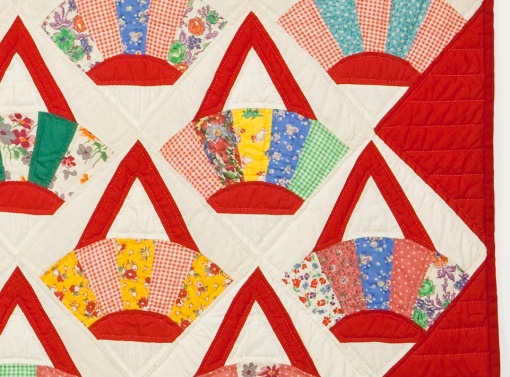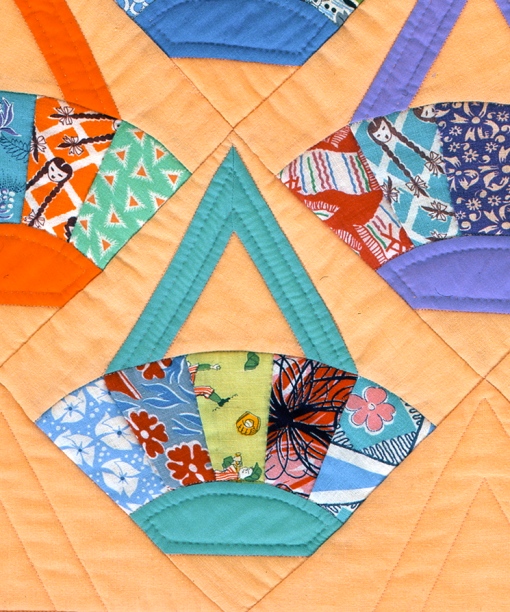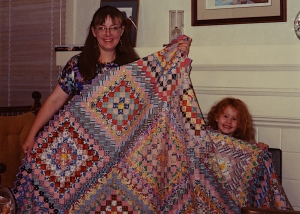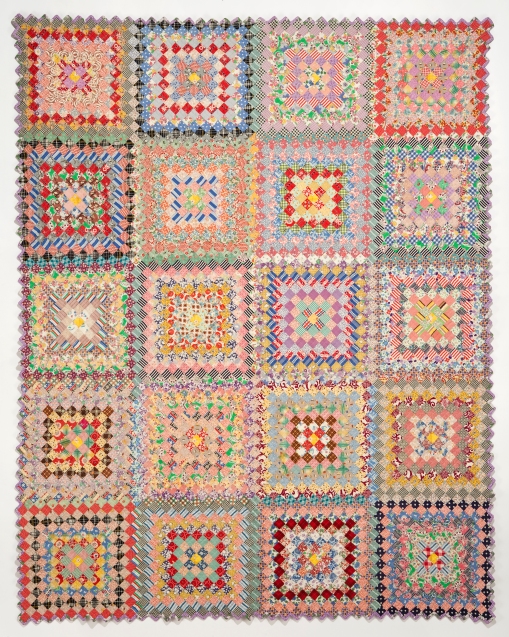I know I have written this a thousand times, but I just LOVE this quilt. Perhaps the key is that it is RED.
I found this quilt top on a trip to the quilt festival in Houston in 1995, and the sales tag indicated that it was made in Ponca City, Oklahoma. Barbara Brackman’s Encyclopedia calls this block Unnamed Basket. This seems too vague for such a powerful form, but then I couldn’t come up with anything more creative either, so I kept it simple.
Red Baskets 69″ x 82″ Photography by Sibila Savage
Since I loved this top so much, I sent it off to Quilting Plus for hand quilting right away. They did a wonderful job.
Here are some detail photos showing the great vintage fabrics. Click on any photo for and enlarged view.
Red Baskets was featured in Mary Mashuta’s book Cotton Candy Quilts, which also includes a pattern for the block.
I also made a copy of this quilt for Mary’s book. I used the foundation piecing technique, making the blocks in a manner similar to Fan Block construction. For my small quilt, I wanted to use as many original vintage solids as I could find in my collection, as well as some of my favorite vintage fabrics and feed sacks. This piece was both hand and machine quilted.
 Rainbow Baskets, 2000 33.5″ x 34″ Photography by Sibila Savage
Rainbow Baskets, 2000 33.5″ x 34″ Photography by Sibila Savage
Rainbow Baskets, detail
And while I was photographing the top for my journal, Maggie got in the picture, too.















Starshine: foundation piecing
24 05 2013Having taken the beginner class in foundation piecing** from Jane Hall and Dixie Haywood in Houston, I jumped at the chance to study with foundation-piecer extraordinaire Karen Stone when she came to EBHQ in the late 90’s to speak and teach classes. My Starshine quilt is the product of that class and is made from Karen’s Lady Liberty pattern.
Karen has a wonderful technique for identifying the different areas of the block and then distributing the different colors within these areas. In addition, she taught us the intricacies of using foundations to make sewing the curved seams easier.
For this quilt, I used the same color palette as my Triad quilt (seen here), adding purple as an extra color. And note how intense these colors seem when the quilt is photographed on a black background.
Here is a detail of four blocks put together.
What surprises me about this quilt today is its lack of quilting. I know I was having trouble at this time trying to figure out how to machine quilt these creations of mine that have soooooo many different fabrics in them. What color thread is best for the quilting? Will you even see the quilting on these blocks? It seems I took the easy way out and quilted the whole thing in the ditch. Might do it differently today.
This quilt is another example of my discounting my work merely because it was made using someone else’s pattern. I loved making it, and I love the product, but I folded it up and put it aside, writing it off as a so-so work, and not thinking much more about. It was not until I was showing some of my quilts to a group of non-quilters that I had a change of heart. One of the group pulled this quilt off the storage shelf, opened it up, and raved about it, so I looked at it again with new eyes. It’s really kinda cool.
________________
P.S. . . .
A couple more of the fabric postcards I’m working on, not finished yet. Afraid I’m becoming obsessed.
______________________________
**Jane and Dixie always call their work “foundation piecing” to distinguish it from English paper piecing (EPP), which is a method done by hand.
Comments : 2 Comments »
Tags: Dixie Haywood, fabric postcards, foundation piecing, Jane Hall, Karen Stone, Lady Liberty, paper piecing
Categories : Observations and insights, Quilts and commentary